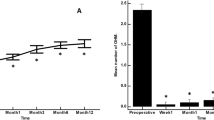Abstract
Background/Objectives
PRESERFLO MicroShunt implantation is a relatively new and increasingly popular treatment for recalcitrant glaucoma. Though relatively uncommon, persistent or severe postoperative hypotony may occur and its treatment presents a significant challenge.
Subjects/Methods
Interventional case series of the first 7 consecutive patients who underwent the insertion of a rip-cord suture to treat severe or persistent postoperative hypotony.
Results
In 6 patients, the hypotony resolved and vision was restored. The 7th patient had suffered a severe suprachoroidal haemorrhage with a poor visual recovery and limited follow-up, so success was more difficult to assess.
Conclusions
Stenting the PRESERFLO MicroShunt with a rip-cord suture is a simple technique to correct persistent or severe postoperative hypotony.
This is a preview of subscription content, access via your institution
Access options
Subscribe to this journal
Receive 18 print issues and online access
$259.00 per year
only $14.39 per issue
Buy this article
- Purchase on Springer Link
- Instant access to full article PDF
Prices may be subject to local taxes which are calculated during checkout

Similar content being viewed by others
Data availability
The dataset generated or analysed during the current study is available from the corresponding author on reasonable request.
References
Pinchuk L, Riss I, Batlle JF, Kato YP, Martin JB, Arrieta E, et al. The development of a micro‐shunt made from poly(styrene‐ block ‐isobutylene‐ block ‐styrene) to treat glaucoma. J Biomed Mater Res. 2017;105:211–21.
Baker ND, Barnebey HS, Moster MR, Stiles MC, Vold SD, Khatana AK, et al. Ab-Externo MicroShunt versus trabeculectomy in primary open-angle glaucoma. Ophthalmology. 2021;128:1710–21.
Scheres LMJ, Kujovic‐Aleksov S, Ramdas WD, Crom RMPC, Roelofs LCG, Berendschot TTJM, et al. XEN® Gel Stent compared to PRESERFLOTM MicroShunt implantation for primary open‐angle glaucoma: two‐year results. Acta Ophthalmol. 2021;99. https://onlinelibrary.wiley.com/doi/10.1111/aos.14602.
Batlle J, Fantes F, Riss I, Pinchuk L, Alburquerque R, Kato Y, et al. Three-year follow-up of a novel aqueous humor MicroShunt. J Glaucoma. 2016;25:e58–65.
Batlle JF, Corona A, Albuquerque R. Long-term results of the PRESERFLO® MicroShunt in patients with primary open-angle glaucoma from a single-center non-randomized study. J Glaucoma. 2020. https://journals.lww.com/10.1097/IJG.0000000000001734.
Schlenker MB, Durr GM, Michaelov E, Ahmed IIK. Intermediate outcomes of a novel standalone Ab Externo SIBS microshunt with mitomycin C. Am J Ophthalmol. 2020;215:141–53.
Arrieta EA, Aly M, Parrish R, Dubovy S, Pinchuk L, Kato Y, et al. Clinicopathologic correlations of poly-(styrene-b-isobutylene-b-styrene) glaucoma drainage devices of different internal diameters in rabbits. Ophthalmic Surg Lasers Imaging. 2011;42:338–45.
Barberá MI, Hernández-Verdejo JL, Bragard J, Burguete J, Fernández LM, Rivero PT, et al. Evaluation of the ultrastructural and in vitro flow properties of the PRESERFLO MicroShunt. Trans Vis Sci Tech. 2021;10:26.
Shin DY, Jung KI, Park HYL, Park CK. Risk factors for choroidal detachment after ahmed valve implantation in glaucoma patients. Am J Ophthalmol. 2020;211:105–13.
Iwasaki K, Kakimoto H, Arimura S, Takamura Y, Inatani M. Prospective cohort study of risk factors for choroidal detachment after trabeculectomy. Int Ophthalmol. 2020;40:1077–83.
Fannin LA, Schiffman JC, Budenz DL. Risk factors for hypotony maculopathy. Ophthalmology. 2003;110:1185–91.
Micheletti E, Riva I, Bruttini C, Quaranta L. A case of delayed-onset hemorrhagic choroidal detachment after PreserFlo Microshunt implantation in a glaucoma patient under anticoagulant therapy. J Glaucoma. 2020;29:e87–90.
Author information
Authors and Affiliations
Contributions
All authors (SA, JHT, KB) have made substantial contributions to the conception and design of the work, the acquisition, analysis and interpretation of data or in the preparation of the manuscript.
Corresponding author
Ethics declarations
Competing interests
KB has received lecturing and consultancy fees from the Santen Pharmaceutical Company Ltd. SA-M receives salary support from a charitable donation by Martin-Baker Ltd. Y-HT declare no competing interests.
Additional information
Publisher’s note Springer Nature remains neutral with regard to jurisdictional claims in published maps and institutional affiliations.
Rights and permissions
Springer Nature or its licensor (e.g. a society or other partner) holds exclusive rights to this article under a publishing agreement with the author(s) or other rightsholder(s); author self-archiving of the accepted manuscript version of this article is solely governed by the terms of such publishing agreement and applicable law.
About this article
Cite this article
Aguilar-Munoa, S., Tham, YH. & Barton, K. A simple surgical solution for the treatment of persistent postoperative hypotony after PRESERFLO MicroShunt implantation. Eye 37, 2126–2129 (2023). https://doi.org/10.1038/s41433-022-02301-1
Received:
Revised:
Accepted:
Published:
Issue Date:
DOI: https://doi.org/10.1038/s41433-022-02301-1



